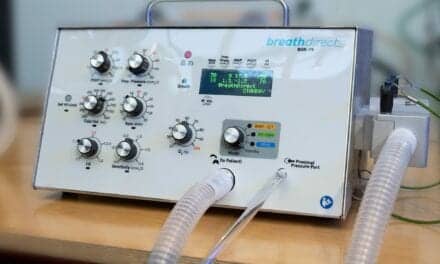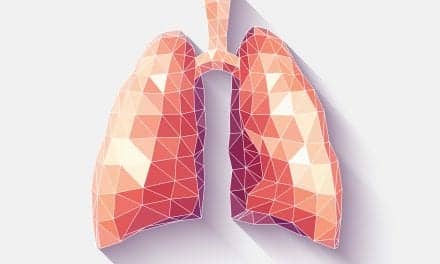RT consulted leaders in patient monitoring technology to find out how pulse oximetry is evolving and how devices are improving chronic respiratory disease management.
By Cassandra Perez
RT Magazine recently spoke with two experts on this technology and gained their insight on new innovations in pulse oximetry, the market for this industry, and the features that can most benefit patients. Participating in this month’s discussion were:
- Mark VanderWerf, vice president, Strategic Relationships, director of OEM and eHealth, Nonin Medical Inc; and
- David Berlin, senior global marketing manager, Remote Patient Monitoring, Covidien
RT: The patient monitoring market, including pulse oximetry, has been steadily increasing. What do you believe is driving this growth?
Mark VanderWerf (Nonin Medical): The patient monitoring market is expanding, especially in low acuity portions of hospitals and in the home. In addition, the use of pulse oximetry is growing within these environments. There are a number of issues driving this growth in Spo2 measurement, such as pulse oximetry becoming a more widely accepted measurement for follow-up of patients with pulmonary issues (including smoking) and the incidence of chronic obstructive pulmonary disease (COPD) appearing to be on the rise … likely a reflection of aging Baby Boomers.
I do not fully understand the sudden increase in the sales of consumer grade/recreational use pulse oximeters in drugstores, like Wal-Mart and on the Web. I am not sure what they are being used for. However, Nonin Medical draws a clear line between consumer/recreational devices and devices used in a clinical setting. Our focus is on pulse oximeters for professionals and their patients, and in recreational uses where either accuracy is critical (pilots, for example) or for other users who value Nonin Medical’s clinical performance.
David Berlin (Covidien): At Covidien, we believe awareness of the dangers of respiratory compromise, particularly in lower acuity areas of the hospital, is driving hospitals’ commitment to the expanded use of continuous monitoring of respiratory function. A growing body of evidence suggests that patient monitoring strategies encompassing not only pulse oximetry, but also respiratory rate and capnography may have the potential to reduce the likelihood and severity of respiratory compromise, and potentially save lives through earlier detection.1-3
In addition, The Joint Commission, Centers for Medicaid and Medicare Services, National Patient Safety Foundation, and other patient safety advocacy organizations have published guidelines and recommendations that bring to light the demonstrated safety continuous monitoring offers for patients at risk for respiratory compromise.
RT: Please discuss your company’s most recent innovations in pulse oximetry technology. What are they focused on? How are they improving patient monitoring?
VanderWerf: Nonin Medical’s focus is quality, accuracy, and clinical performance in pulse oximetry. For these reasons, Nonin pulse oximeters are the preferred choice of pulmonologists and respiratory therapists. In addition, Nonin remains the finger pulse oximeter of choice for the US military.
Recent innovations in SpO2 are occurring in two areas: Ease of integration into multiparameter monitors. Nonin provides both internal modules and external solutions (such as our Xpod OEM pulse oximeter) that deliver the accuracy and performance that customers expect from Nonin, but within systems built by others; and Wireless.
Wireless innovations include: Nonin’s Onyx II Model 9560 wireless finger pulse oximeter remains the industry standard for Bluetooth Classic 2.0 devices. The 9560 is sold worldwide integrated into systems for a variety of clinical environments; Nonin’s WristOx2 Model 3150 is the leader in wearable pulse oximeter technology. It is used worldwide in assessment, 6-minute walk testing, home oxygen therapy, and sleep diagnostics; Nonin’s new 3230 Bluetooth Smart Pulse Oximeter is the leading Bluetooth Smart (4.0) pulse oximeter delivering clinical performance in a device that can integrate to standard smartphone and tablet platforms (IOS, Android, and Windows 8). It is the winner of the 2014 Bluetooth Award. Its sister product, the Model 3231 pulse oximeter, provides simplified USB connectivity and Expanded measurement at the fingertip. Watch for Nonin Medical announcements in the coming months.
Berlin: Covidien is focused on raising awareness of respiratory compromise and providing solutions that help clinicians identify this patient safety threat sooner.
Respiratory compromise is a significant issue that is common, costly, and often deadly. Recent data has shown that nearly 30% of postoperative patients1 and up to 7% of all Medicare patients2 will suffer from respiratory compromise. By 2019, the cases of respiratory compromise are expected to rise to 31% of all Medicare patients.2 The associated costs from these issues will surpass $37 billion by 2019.2 A great deal of that cost is due to the fact that patients with respiratory compromise on the general care floor will be in the hospital for 7 days longer and those in the ICU for almost 3 days longer.3 In addition, the patients with respiratory compromise on the general care floor are 29 times more likely to die compared to general care floor patients without respiratory compromise.3 The issue of respiratory compromise is very real and growing quickly.
The Nellcor Respiration Rate System is one of Covidien’s most recent pulse oximetry innovations that may enable earlier intervention in cases of respiratory compromise. This unique technology provides continuous respiratory rate and pulse oximetry assessments through a single finger sensor. It enables clinicians to review respiratory trend data over the course of a patient’s treatment, and the software upholds an accuracy of ±1 breath per minute when compared to respiration rate derived from a capnography- based reference.4
RT: How are developments with wireless oximetry and smartphone-integrated oximetry influencing the market? Do they influence your company’s product development?
VanderWerf: Integration to mobile platforms is already having a profound impact on applications and ease of use. It is pushing the industry toward real-time, mobile applications and the results are compelling. Examples include: Easy-to-use, real-time testing like CareFusion’s new 6-minute test application that provides real-time data to a mobile platform as well as connectivity to the EMR.
We see this as a promising trend, and there will be others in this space; and home and ambulatory chronic disease monitoring solutions have become simpler and lower cost. These applications have proven significant reductions in rehospitalization for chronic disease patients and reduced costs of care. Almost all of the quality providers of these systems and services use Nonin Medical.
Berlin: Wireless and smartphone-integrated patient monitoring is poised to revolutionize healthcare, and could help save lives, improve quality of care, and reduce costs for both patients and healthcare providers. That’s why Covidien is keenly focused on both wireless and remote monitoring technologies.
The Vital Sync VPMP 2.4 platform from Covidien gives clinicians the ability to remotely view vital information from not only pulse oximeters, but multiple device categories, including ventilators, and capnography monitors. The software wirelessly transmits patient information from the bedside to a hospital’s server. From there, clinicians can view the data within the hospital network on any web-enabled device: smartphones, tablets, desktops, workstation on wheels, and nurse stations.
In addition, the ZephyrLIFE Hospital remote patient monitoring (RPM) system from Covidien combines the collection of multiparameter vital signs, wireless communications, and an intuitive notification engine to deliver seamless patient monitoring for general care. It allows for the simultaneous portal-based monitoring of multiple patients every 15 minutes. This secure, standalone patient management tool provides monitoring of vital signs, including SpO2, ECG recordings, activity, and position, and may allow for a contextual assessment of a patient’s status.
With such advanced remote monitoring capabilities, clinicians can monitor patients in broader environments, which may lead to a significant decrease in the number of 30-day readmissions—something one in five patients currently experience. With readmission costs totaling more than $25 billion annually, remote monitoring has the potential to reduce healthcare expenses.1 At the same time, the technology could help improve patient outcomes.
RT: In your estimation, what new customized capabilities for pulse oximetry devices are most beneficial to healthcare professionals and protecting patient safety?
VanderWerf: Customized capabilities and target market focused applications will make it easier for healthcare professionals because these applications will be specialized to address the unique needs of individual specialties and specific disease states.
A key to patient safety is accuracy of measurement and the ability to accurately record patient data to the EMR and then access this data on a timely basis. These new custom, purpose-built applications include these capabilities.
Berlin: In addition to continuous respiratory function monitoring technologies and wireless and remote technologies mentioned above, Covidien’s alarm management solutions are a customizable pulse oximetry capability designed to improve patient safety. An estimated 85% to 99% of alarms in healthcare facilities don’t require clinical intervention.1,2 Because of this high percentage of insignificant alerts, clinicians can develop “alarm fatigue,” which can result in their tuning out these notifications and missing the alarms that truly signal a patient’s critical medical crisis.
That’s why device manufacturers are creating technology to help prevent false alarms, such as Covidien’s Nellcor SatSeconds clinician-controlled alarm management. This alarm management tool differentiates between serious oxygen desaturations and minor transient events by taking into account both the depth and duration of a patient’s desaturation.
As a result, clinicians can evaluate brief desaturation events in context with their depth, and shallow desaturations in context with their duration. This means that instead of having an alarm sound every time a patient’s saturation value crosses the threshold, an alarm sounds only when a desaturation event is clinically significant to the patient’s condition, based on settings determined/assigned by the clinician. With SatSeconds alarm management, hospitals may minimize clinically insignificant desaturation alarms by more than 60% without affecting patient safety.
RT: What do you feel is on the horizon in the pulse oximetry market? How do you think it will evolve in the next 10 years?
VanderWerf: I have both optimism and concerns. Optimistically, I believe pulse oximetry will become a more standard measurement for all the reasons given above. The importance placed on pulmonary disease management is already increasing.
In the clinical environment, testing regimens, patient monitoring, and results collection will be easier. The use of algorithms to stratify results and patients will be more common. The data transfer to EMR systems will become more automatic. The rapid move toward mobile platforms and monitoring patients in their homes and in their daily lives will be great for payors and providers to reduce hospitalization and reduce cost, but it will also elevate the patient’s ability to participate in the management of his or her disease. The result is better management, greater independence, and a lower rate of exacerbations and acute events. This improves patients’ lives and the lives of their caregivers in very real terms.
On the other hand, I am concerned that in the rush to develop and deploy “cool” mobile platforms and move to the home, we might get overexcited about the technology. The rush toward convenience and low cost might inadvertently move some away from the necessary focus on quality and patient safety. Proper treatment requires reliable, clinical accuracy. Professionals require clinical accuracy even in challenging patients (like those with low perfusion, motion, and rapid desaturation).
Berlin: Just as our unique Nellcor Respiration Rate technology provides this physiologic data via a single, finger sensor, Covidien will remain strategically focused on bringing vital patient information to clinicians in new ways. We also well understand that clinicians do not make decisions based on a single parameter, and we continue to drive a broad portfolio of monitoring solutions that provide a complete assessment of patient respiratory function status with our SpO2, RR, and EtCO2 monitoring solutions.
Additionally, we believe that advancements in wireless and remote monitoring of pulse oximetry and other parameters will lead to the integration of home monitoring technologies becoming standard of care for patients with chronic diseases. Evidence to date suggests that home surveillance of these patients has the potential to provide early detection of clinical deterioration, and reduce readmission rates and cost of care.
Remote monitoring technology suitable for these indications is constantly evolving. The continued integration of these home surveillance technologies into the standard of care for patients with chronic disease and patients with certain acute conditions has the potential to improve patient outcomes and reduce the cost of care.
And the technology has potential beyond patient care. Mobile health monitoring devices now provide helpful insights about the impact of daily activities. Consumers use mobile applications to track food consumption, exercise, and sleep patterns. Not only do these applications assist the average person in leading a healthier life, but they also have the potential to reduce healthcare issues in the not-so-remote future. RT
For more information, contact [email protected].










